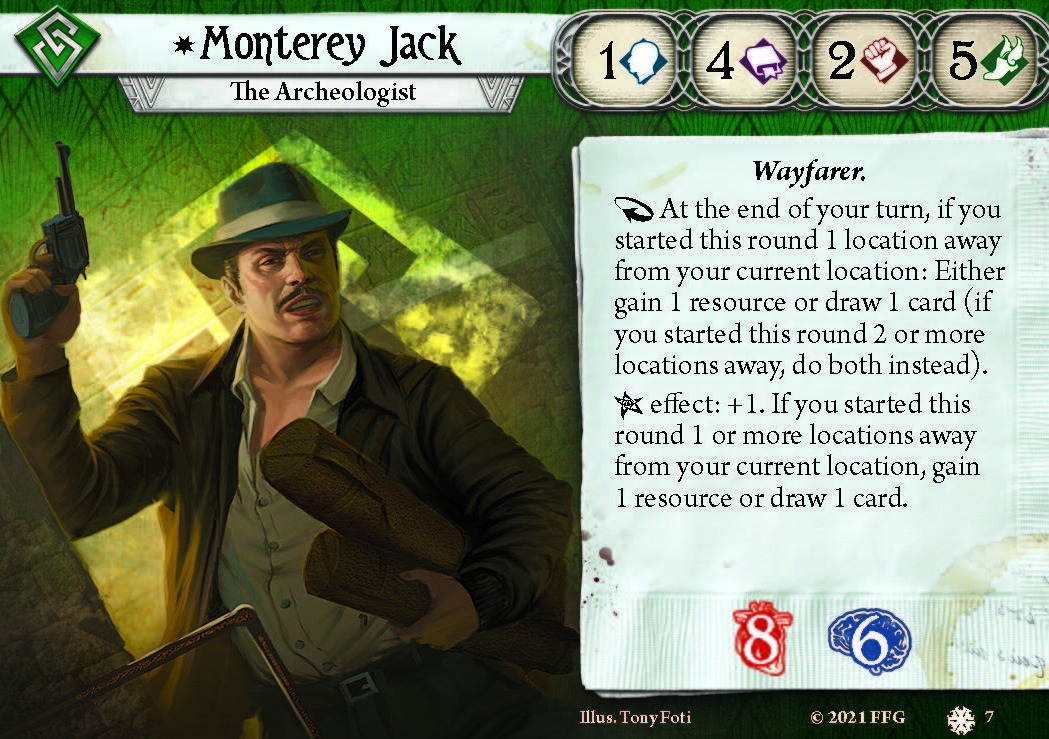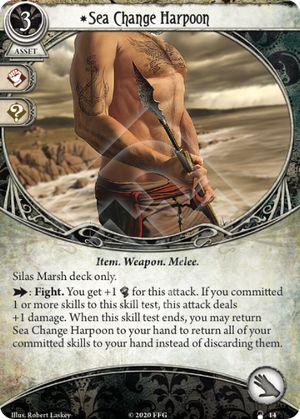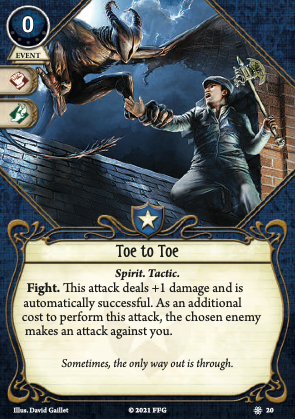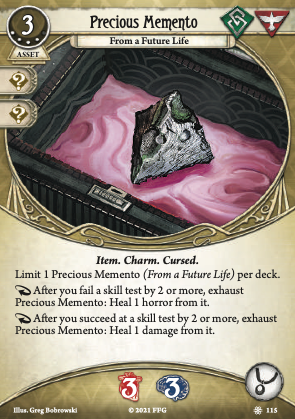
Wow, what a character. An absolute mad lad. I just ran him through innmouth conspiracy(solo) and he is absolutely bonkers. Many people have said it already, But I got to spend a minute to talk about him.
One of the most horrendous actions in this game, is moving. It's a necessary evil. You HAVE to move to another location. That's why movement cards like short-cut, scout ahead, pathfinder, estocic atlas are of great value. Especially in campaigns with Huge maps, like innsmouth and edge of the earth. Spending 1 of your few action just to move always feels bad.
Now, what if I told you, that there was a gator, that, when he moves, he pays you for it?!? It's your boy, Monterey Jack. Now, rogues have always had the capital when it comes to resources, but this seeking rogue can NOT take those powerful resource cards. But he can still get by, with cards like lonewolf, or Faustian bargain, but it's nice nevertheless that he can innately get more resources for his move actions. Now what rogues aren't good at, is card draw. Barring lucky cigarette case,pickpocket,easy mark, 3 aces, and all in. Mosty they have powerful draw effects. But never any consistent card draws. But this rogueish seeker not only has access to the best seeker cards, but can innately draw cards with his move actions as well.
Not Many investigators have an ability that is so versatile. If you don't need resources, you can draw a card. If you don't need a card, you can gather a resource. You are completely flexible that way. If you start to add in those powerful movement cards as mentioned,(especially pathfinder and eon charts) his ability becomes crazy, with so much overflowing tempo.
All of those nice things said. He is heavily effected in multi-player, and clue heavy location. In single player. This is a nice balance, there is not many clues on many location, so his ability can run wild and free. But more players invites more clues, and with it. A deck building challenge to really clean up clues. You can totally manage it, with cards like pifer, fingerprint kit, deduction, archaic glyphs and what not. Hell, he CAN take the best of what the seekers can offer, so why not? I would advise a secondary seeker, or a good generalist in 3-4 players, but he can be a main cluever in duos, definitely.
Also, a special case, in horror in high gears, you are glued to the vehicle, and the vehicle is forced to move at the end of the investigation phase, but not the turn. Which means if I didn't force it. (The ability on the vehicle card) I would never use my ability. Which sucked! But anyways, let's look at his stats.
1 will
This Stat is never good. Although, rogues are used to low willpower anyways, so if your teamed, the usual suspect can help,(you handle this one, I'll handle this, ward of protection.) You will need to soak horror, and you will have to iron out some ways to deal with important will test.... or just don't do them, I guess. I can suggest a few option, especially if your playing solo.
-
forewarned(1)- you are pretty good at getting clues, so it's not so bad, especially if the effect you are canceling would make you worst off.
-
Higher education(3)- you bet your bottom dollar I'll spend 2-3 resources to save my behind in a important will test, you can have an abundance of resources, you can fill your hand easy, and can use both Stats. I would say it's not a priority upgrade. But if you have the spare exp. Why not?
-
Skill cards- you can totally save an unexpected courage, and a inquiring mind to pass a hard will test. Hell, with some spare exp, I bout eye of truth(5) which is already a stellar card. You won't be able to do this offen, so choose wisely.
Sadly, he has 6 sanity, which Will test usually revolve around horror, so I recommend Logical reasoning or logical reasoning(4) which in general is a good card, but on him it's pretty great, not many(if any) rogues can say they have played it.(The lvl 4 version of course).
4 Intellect
A pretty solid Stat, and with 1-5 seeker access, comes many ways in utilizing it. Stand out cards are mag glass(1) of course, Dr Milan, and death(1).you also have access to many seeker researched cards , and also the new archive of conduits. He can provide excellent seeker support, while utilizing his rogueish card pool. Fun cards including
-
Eon chart(1)(4) - an excellent enabler that allows him to do 3 different things that he is good at. You can keep it charged with ariadne's twine(3)! My favorite!
-
Gené Beauregard(3)- an decent multi-player card. Boost two stats he likes, and provides him additional ability when he moves, this asset pairs greatly with hiking boots(1)!
2 Fight.
It's just as bad as his will Stat. But it's not nearly as important. This Stat comes up mostly when you fight.... which with his ability to move and his high Agility, he usually just wants to Evade. His signature asset, his trusty bullwhip, is an excellent panic weapon, and allows him to take out small annoyances. He can fight bosses with this weapon in solo for sure. But he really isn't a main fighter. Your job is to Evade, Investigate and get out of dodge. Enemy management will be an issue sometimes, so try to be prepared. The rogue 0 cards like backstab, sneak attack, hell even hatchet man will do some work.
side note- you can use the ornate bow, he doesn't have the best pool, but since he likes evading, you can make great use of this.however,you will lose your handslots tho
5 Agility
Speaking of which, this is the rogues stock and trade! But sadly, he is the worst rogue for this. He can't use some of the best rogue cards, also he doesn't have many ways of boosting his Agility. That said. Seeker still has great support for this Stat, I actually stated some cards (gené,hiking boots) that co-exist to help him boost this Stat.
His Signature Card- Trusty Bullwhip- I've talk about it alittle, but what's not to like? It's cheap, fast, and tests with his best Stat. It has that same versatile nature that his ability has, extra damage? Or auto Evade? Or nether, than attack again? Your call.
His Signature Weakness- Buried Secrets-
One of the more tamer weakness I've seen. I mean, he is good at investigating, so if anything it's a waste of a action. Or maybe not, because it has the bold Investigate. You can use a card like eon chart to investigate with it (current taboo actually prevents this now). And if you fail, but you really have to move, you can alway shuffle it back into your deck for 2 horror, you'll see it again, but probably in better circumstances.
All in all, he is an excellent investigator. That allows for quick, fast pace games were he lives on the run, and profits the most from it. Truly, a fun time!



